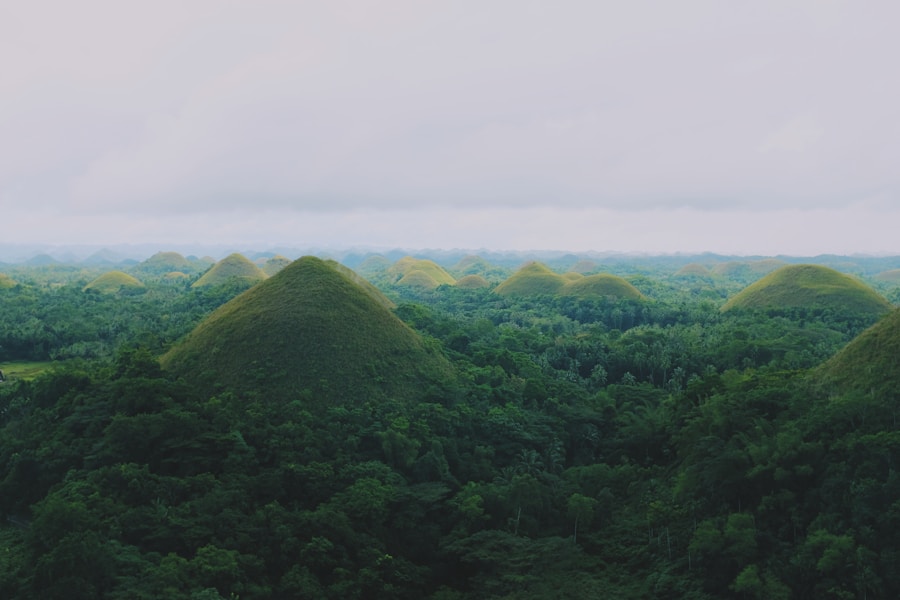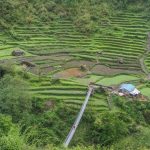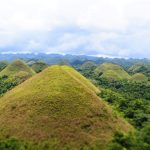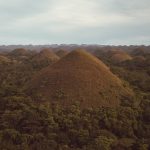Download links
How to install Exploring the Enigmatic Beauty of Chocolate Hills APK?
1. Tap the downloaded Exploring the Enigmatic Beauty of Chocolate Hills APK file.
2. Touch install.
3. Follow the steps on the screen.
Description
The Chocolate Hills, a geological wonder located in the Bohol province of the Philippines, are a striking natural formation that has captivated both scientists and tourists alike. These hills, numbering over 1,200, rise dramatically from the surrounding landscape, creating a unique and picturesque panorama. The formation of these hills is attributed to a combination of geological processes, primarily limestone erosion.
The region is characterized by its karst topography, which is formed when soluble rocks such as limestone dissolve over time due to the action of water. This process leads to the creation of sinkholes, caves, and, ultimately, the distinctive conical hills that we see today. The Chocolate Hills are believed to have formed approximately 1 to 2 million years ago during the Pleistocene epoch.
The initial stages of their formation involved the uplift of coral deposits from the ocean floor, which were then subjected to extensive weathering and erosion.
The unique conical formations are a result of this erosion process, where softer materials were worn away more quickly than the harder limestone.
The hills are particularly striking during the dry season when the grass covering them turns brown, giving them a chocolate-like appearance, hence their name.
Key Takeaways
- The Chocolate Hills are a unique geological formation in the Philippines, consisting of over 1,200 cone-shaped hills.
- The flora and fauna of the Chocolate Hills include a variety of plant and animal species, some of which are endemic to the area.
- According to legend, the Chocolate Hills were formed from the tears of a giant who was mourning the death of his beloved.
- Conservation efforts are in place to protect the Chocolate Hills from environmental degradation and human impact.
- Tourists can enjoy activities such as hiking, bird watching, and ATV riding while visiting the Chocolate Hills, and can also sample local delicacies made with chocolate, such as chocolate rice cakes and hot chocolate.
Flora and Fauna of Chocolate Hills
Unique Plant Species
Grasses dominate the landscape, with species such as cogon grass (Imperata cylindrica) and various types of wildflowers adding splashes of color throughout the year. The hills are also dotted with shrubs and small trees that have adapted to the rocky terrain. These plants play a crucial role in preventing soil erosion and maintaining the ecological balance of the region.
A Habitat for Various Animal Species
In addition to its diverse flora, the Chocolate Hills are also a habitat for various animal species. Birds are particularly abundant in this region, with species such as the Philippine tarsier and the Philippine eagle being notable inhabitants.
Ecological Significance and Conservation
The presence of these animals highlights the ecological significance of the Chocolate Hills and underscores the need for conservation efforts to protect their habitat. The tarsier, one of the world’s smallest primates, is known for its large eyes and nocturnal habits. It primarily feeds on insects and small vertebrates, making it an essential part of the local ecosystem.
The Legend and Folklore Surrounding Chocolate Hills

The Chocolate Hills are steeped in local legend and folklore, adding an enchanting layer to their already captivating presence. One popular tale tells of two giants who engaged in a fierce battle that lasted for days. As they fought, they hurled boulders at each other, creating the hills as they scattered debris across the landscape.
Once their battle was over, the giants became friends and decided to leave the hills as a reminder of their conflict. This story not only explains the origin of the hills but also reflects the rich cultural heritage of the Boholano people. Another legend speaks of a giant named Arogo who fell in love with a mortal woman named Aloya.
When Aloya passed away, Arogo was heartbroken and wept for her loss. His tears formed the hills that we see today, symbolizing his eternal love and sorrow. This poignant tale resonates deeply with locals and visitors alike, illustrating how natural formations can be intertwined with human emotions and experiences.
Such stories contribute to the allure of the Chocolate Hills, making them not just a geological marvel but also a significant part of Bohol’s cultural identity. For more information on the cultural significance of natural formations, you can visit the National Geographic website.
Conservation Efforts to Protect Chocolate Hills
| Conservation Efforts | Details |
|---|---|
| Protected Area | Chocolate Hills Natural Monument covers an area of 50 square kilometers and is protected by the government of the Philippines. |
| Reforestation | Efforts to replant trees in the surrounding areas to prevent soil erosion and maintain the natural landscape. |
| Community Involvement | Local communities are involved in conservation efforts through education and sustainable tourism initiatives. |
| Research and Monitoring | Scientific studies and monitoring programs are in place to understand the ecology of the Chocolate Hills and track any changes over time. |
Recognizing the ecological and cultural importance of the Chocolate Hills, various conservation efforts have been initiated to protect this unique landscape. The Philippine government has designated the area as a National Geological Monument, which provides legal protection against activities that could harm its integrity. This designation helps ensure that any development or tourism-related activities are conducted sustainably and with minimal impact on the environment.
Initiatives aimed at reforestation and habitat restoration have been implemented to preserve the natural beauty and biodiversity of the region. Educational programs are conducted to raise awareness among residents and visitors about the importance of protecting this unique ecosystem.
By fostering a sense of stewardship within the community, these efforts aim to ensure that future generations can enjoy and appreciate the Chocolate Hills in their natural state.
Tourist Attractions and Activities in Chocolate Hills
The Chocolate Hills have become a major tourist destination in the Philippines, attracting visitors from around the world who come to marvel at their beauty and engage in various activities. One of the most popular attractions is the viewing platform located at Chocolate Hills Complex, which offers panoramic views of the hills and surrounding landscape. From this vantage point, visitors can appreciate the sheer scale and symmetry of these geological formations, especially during sunrise or sunset when the light casts dramatic shadows across the hills.
In addition to sightseeing, tourists can partake in various outdoor activities that allow them to explore the area more intimately. Hiking trails wind through the hills, providing opportunities for adventure enthusiasts to trek through lush vegetation while enjoying breathtaking views at every turn. For those seeking a more leisurely experience, ATV rides offer an exhilarating way to navigate through the rugged terrain while taking in the stunning scenery.
Furthermore, local guides often share insights about the geology, flora, and fauna of the region, enriching visitors’ understanding of this remarkable landscape.
The Culinary Delights of Chocolate Hills

While visiting the Chocolate Hills, tourists can also indulge in a variety of culinary delights that reflect Bohol’s rich cultural heritage. Local cuisine is heavily influenced by fresh ingredients sourced from both land and sea, resulting in dishes that are bursting with flavor. One must-try dish is “lechon,” a succulent roasted pig that is often served during special occasions and celebrations.
The crispy skin and tender meat make it a favorite among locals and visitors alike. In addition to lechon, Boholano cuisine features an array of seafood dishes that highlight the region’s coastal resources. Freshly caught fish, shrimp, and squid are commonly prepared using traditional methods such as grilling or steaming.
One popular dish is “kinilaw,” a Filipino version of ceviche made with raw fish marinated in vinegar and citrus juices, often garnished with onions and chili peppers for added flavor. These culinary experiences not only satisfy hunger but also provide insight into Bohol’s vibrant culture and traditions. The Chocolate Hills are not just a feast for the eyes; they also offer an opportunity for visitors to immerse themselves in local flavors and culinary practices.
From street food stalls offering snacks like “suman” (sticky rice cake) to upscale restaurants serving gourmet interpretations of traditional dishes, there is something for every palate. This gastronomic journey complements the breathtaking scenery and rich history of the Chocolate Hills, making it an unforgettable destination for travelers seeking both adventure and cultural enrichment.
FAQs
What are the Chocolate Hills?
The Chocolate Hills are a geological formation located in the Bohol province of the Philippines. They are made up of around 1,200 to 1,776 conical limestone hills, which are covered in green grass that turns brown during the dry season, giving them a chocolate-like appearance.
How were the Chocolate Hills formed?
The exact formation process of the Chocolate Hills is still a subject of debate among geologists. One theory suggests that they are the weathered formations of a marine limestone on top of an impermeable layer of clay. Another theory proposes that they are the result of the uplift of coral deposits and the action of rainwater and erosion.
What is the significance of the Chocolate Hills?
The Chocolate Hills are a major tourist attraction in the Philippines and are considered a natural wonder. They have been declared the country’s third National Geological Monument and proposed for inclusion in the UNESCO World Heritage List.
Can visitors explore the Chocolate Hills?
Yes, visitors can explore the Chocolate Hills by climbing the viewing deck in the town of Carmen or by taking a guided tour. There are also hiking trails and ziplines available for those who want to experience the hills up close.
Are there any legends or myths associated with the Chocolate Hills?
According to local folklore, the Chocolate Hills were formed from the tears of a giant named Arogo, who wept over the death of his beloved mortal girlfriend. Another legend tells of two feuding giants who hurled rocks, boulders, and sand at each other, which eventually formed the hills.





